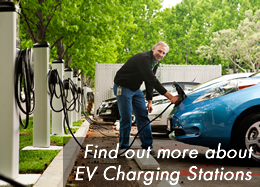| |
There are many simple ways to reduce the footprint you leave on the planet. Learn how to reduce your footprint in each consumption category–carbon, food, housing, and goods and services—but don’t stop there. Amplify your impact by encouraging others to follow your lead. Engage your friends and community with local and global movements for social change, or start your own movement!
Reduce your Carbon Footprint
Use Cleaner Transport
- Walk, bike, or take public transit whenever possible.
- Avoid allowing your car to idle. If you’ll be waiting for more than 30 seconds, turn off the engine (except in traffic). And don’t take the drive-through. Park the car and walk inside instead.
- Have your vehicle serviced regularly to keep the emission control systems operating at peak efficiency. Check your car’s air filter monthly, and keep the tires adequately inflated to maximize gas mileage.
- Avoid short airplane trips—take a bus or train instead.
Add Energy-Saving Features to your home
- Install compact fluorescent bulbs in all your home light fixtures—but remember, compact fluorescents contain mercury, so look for low-mercury models and be sure to dispose of old bulbs safely through your local hazardous waste program.
- Weatherproof your home. Make sure your walls and ceilings are insulated, and consider double-pane windows. Eliminate drafts with caulking, weather strips, and storm windows and doors.I
- nsulate your water heater. Even better, switch to a tankless water heater, so your water will be heated only as you use it.
- Choose energy efficient appliances.
Adopt Energy-Saving Habits
- Keep thermostat relatively low in winter and ease up on the air conditioning in summer. Clean or replace dirty air conditioner filters as recommended to keep the A/C operating at peak efficiency.
- Unplug your electronics when not in use. To make it easier, use a power strip. Even when turned off, items like your television, computer, and cell-phone charger still sip power.
- Dry your clothes outside whenever possible.
- Make minimal use of power equipment when landscaping.
- Defrost your refrigerator and freezer regularly.
- Choose green electricity. Many utilities give you the option to purchase electricity generated by wind and solar power for a small rate surcharge.
- Purchase carbon offsets to make up for the energy use you can’t eliminate.
Reduce your Food Footprint
- Eat more local, organic, in-season foods.
- Plant a garden—it doesn’t get more local than that.
- Shop at your local farmer’s market or natural foods store. Look for local, in-season foods that haven’t traveled long distances to reach you.
- Choose foods with less packaging to reduce waste.
- Eat lower on the food chain—going meatless for just one meal a week can make a difference. Globally, it has been estimated that 18% of all greenhouse gas emissions are associated with meat consumption.
Reduce your Housing Footprint
- Choose sustainable building materials, furnishings, and cleaning products.
- Explore green design features for your building, like passive solar heating, a rainwater catchment or grey water recycling system, and recycled materials.
- Choose efficient appliances, including low flow shower-heads, faucets, and toilets.
- Choose furnishings that are second-hand, recycled, or sustainably produced.
- Plant drought tolerant plants in your garden and yard.
- Use biodegradable, non-toxic cleaning products.
Adopt Water-Saving Habits
- Take shorter, less frequent showers—this not only saves water, but the energy necessary to heat it.
- Don’t use the garbage disposal. Compost instead.
- Run the dishwasher and the laundry machine only when full.
- Wash cars rarely, or better yet, take them to a carwash. Commercial carwashes use less water per wash than home washers, and they are also required to drain used water into the sewage system, rather than storm drains, which protects aquatic life.
- Avoid hosing down or power-washing your deck, walkways, or driveway.
- Regularly look for and fix leaks.
- Turn off the water when you brush your teeth. If everyone did this simple step we would save the equivalent of the great lakes every year.
- Buy a rain barrel to capture excess rain from the gutters which can be used to water your garden.
Reduce your Goods and Services Footprint
- Buy less! Replace items only when you really need to.
- Recycle all your paper, glass, aluminum, and plastic. Don’t forget electronics!
- Compost food waste for the garden. Garbage that is not contaminated with degradable (biological) waste can be more easily recycled and sorted, and doesn’t produce methane gases (a significant greenhouse gas contributor) when stored in a landfill.
- Buy recycled products, particularly those labeled “post-consumer waste.”
|









